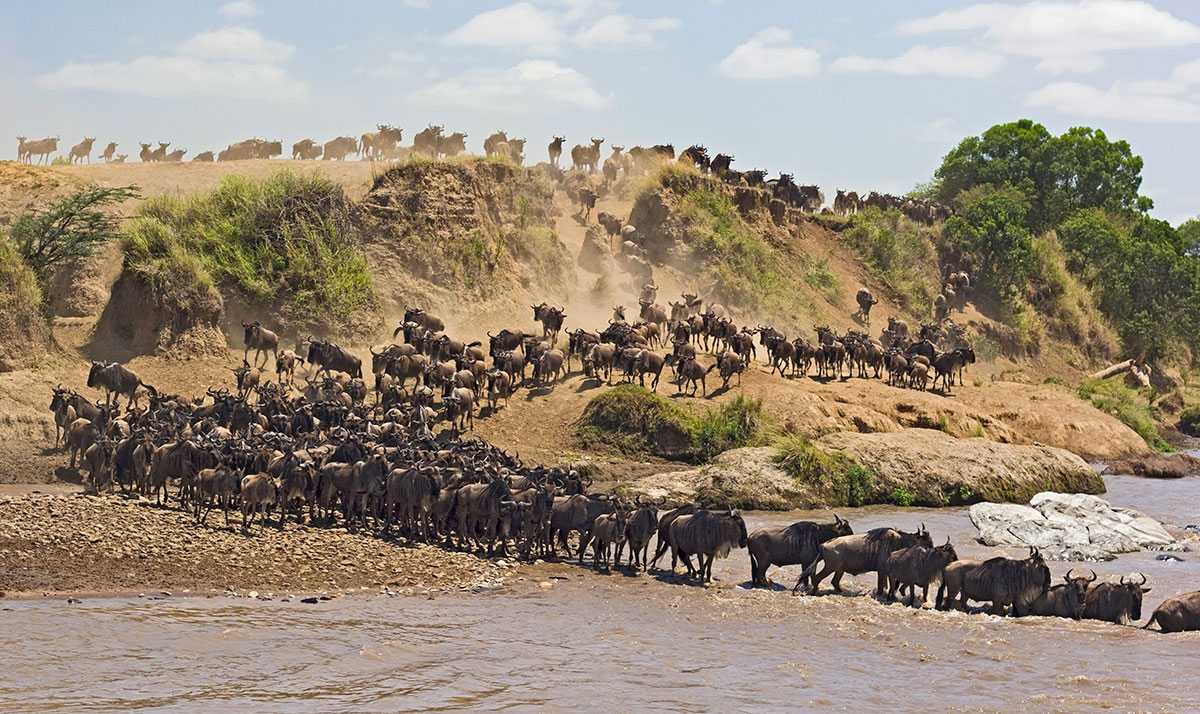What people consider the “best” time is a matter of personal preference regarding weather, wildlife behavior and travel season.
Seasons in Tanzania
The weather in Tanzania cycles between a green season and a dry season. Temperature remains relatively consistent throughout the year, so don’t worry too much about avoiding scorching temperatures. In fact, you’ll probably need to pack a fleece if you plan to visit the Ngorongoro Crater.
High Temperatures: 77 to 82 degrees Fahrenheit
Low Temperatures: 55 to 61 degrees Fahrenheit
Rainfall is a different story. Between the green season and the dry season, the Serengeti falls to a dusty 0.4 inches of rain in July and reaches a high of 5.5 inches of rain in April. Many will recommend not traveling in April because of the frequent showers.
What month should you consider outside of April and what else should affect your decision? Here’s a month-by-month breakdown with pros and cons.
January, February and March
Late January through the middle of March is calving season in the Serengeti. Within a two- to three-week period, roughly half a million wildebeest will give birth on the plains.
They’re joined by elephant calves, lion cubs, wildebeest piglets, zebra foals and much more, as plentiful water and food makes it easier for animals to raise their young.
+ Predators and Chases
All the commotion caused by calving attracts predators as well. If you want to see cheetahs chase wildebeests, leopards ambush gazelles or lions take down zebras, this is one of the best times to safari.
+ Lush Landscapes
It’s not called the green season for nothing. The plains come to life at this time of year – the gold grass replaced by vibrant green plains and flourishing acacia trees.
+ A Favorite Among Experts
Calving season may not be the first thing on a new traveler’s mind, but it’s a big deal to the seasoned experts. It’s one reason 25-year wildlife photographer Paul Joynson-Hicks chooses late March to lead Photography Safaris.
+ Lower Airfare, Fewer Tourists
There are fewer travelers following the holidays, which tends to mean less expensive flights and little traffic in the parks.
– Light Showers
While these months may not be the rainiest in the year, there are some showers. These typically don’t affect game drives, but weather is unpredictable.
– Break Out the Repellent
Mosquitoes and tsetse flies thrive in wetter environments. If you travel in these months, make sure you pack repellent containing DEET and citronella-based repellents.
May and June
+ See the Rut
The rut is the annual mass breeding event for Great Migration wildebeests. Well-fed and healthy thanks to the bountiful green season, bulls will lock horns across the plains to compete for territory and mating prospects.
+ Green Plains with Fewer Showers
The weather will become drier as the green season winds down in the middle of May. This is a great time to dodge the rain and see the vegetation before it dies out.
+ Get an Intimate Experience
You’re more likely to experience secluded wildlife viewing at this time for two reasons: The Great Migration herds spread out across several broad swaths of land during the rut, and fewer tourists are traveling at this time generally.
July through October

+ Easy Wildlife Viewing in Serengeti safari
As the plains dry up, wildlife is forced closer and closer together at the remaining watering holes. It’s rarely difficult to find lots of wildlife in Serengeti safari areas for this reason.
+ Predators Side-by-side with Prey
Water sources are shared by grazers and big cats alike. You stand a better chance of seeing chases and takedowns as water becomes scarce and predators and prey are forced closer together.
+ Opportunities to See River Crossings
As food and water grow scarce, Great Migration herds move north to where food is more plentiful. This leads to thrilling river crossings at the Grumetti River around June/July and the Mara River between July and October.
Keep in mind, river crossings are completely unpredictable, and the window of time one can occur is months long. If you don’t see one, hakuna matata! The Serengeti has plenty more to offer.
+/- The Most Popular Travel Time
The dry season is incredibly popular, so take comfort in the fact that this is a preferred travel time for wildlife enthusiasts around the world.
This can also work against you. More tourist traffic can mean competing against other travelers for the best spots to see the wildlife. Luckily, there’s a lot of Serengeti to go around, so this rarely creates conflicts.
November and December
+ Kick Off the Green Season in Serengeti safari
Short periods of rain replenish the landscape and acacia trees and bring back green grass and blooming flowers.
+ The Best Time for Serengeti safari birding
Over 500 bird species make a home in the Serengeti ecosystem; birders will have a lot to see throughout the year, but bird watching is particularly good starting in November when migratory species move back into the area.
+ Scuba Dive in Zanzibar
The spice island of Zanzibar, right off the coast of Tanzania, pairs well with Serengeti safaris for most of the year. Scuba diving in November and December is good for two reasons.
- Divers dodge much of the tourism traffic coming to Tanzania for the dry season.
- The weather is pleasant (typically sunny and in the mid-80s) with some brief morning rains in early November – particularly good beach weather if you’re escaping winter.
The best time for your safari is all about perspective and what is most important to you. Still unsure about what you’d like to experience? We share recommendations with guests nearly every day! Don’t hesitate to get in touch.

Leave a Reply